University OB Report: Analyzing Leadership Changes in an Organization
VerifiedAdded on 2021/05/31
|5
|911
|26
Report
AI Summary
This report examines the impact of a recent leadership change within an organization, focusing on the introduction of new leadership techniques and their effects on organizational culture and employee behavior. The new leader emphasized team building, shared values, and open communication, leading to both positive and negative outcomes. The report discusses the implementation of Tuckman’s stages of group development, the improvement in individual role clarity, and the enhancement of customer service through the new leadership approach. Increased productivity and employee morale are highlighted as positive impacts, while miscommunication and employee hostility are identified as limitations. The analysis emphasizes the importance of effective communication and employee-friendly policies in achieving organizational goals and competitive advantage. The report references key academic sources to support its findings and offers insights into managing organizational change effectively.
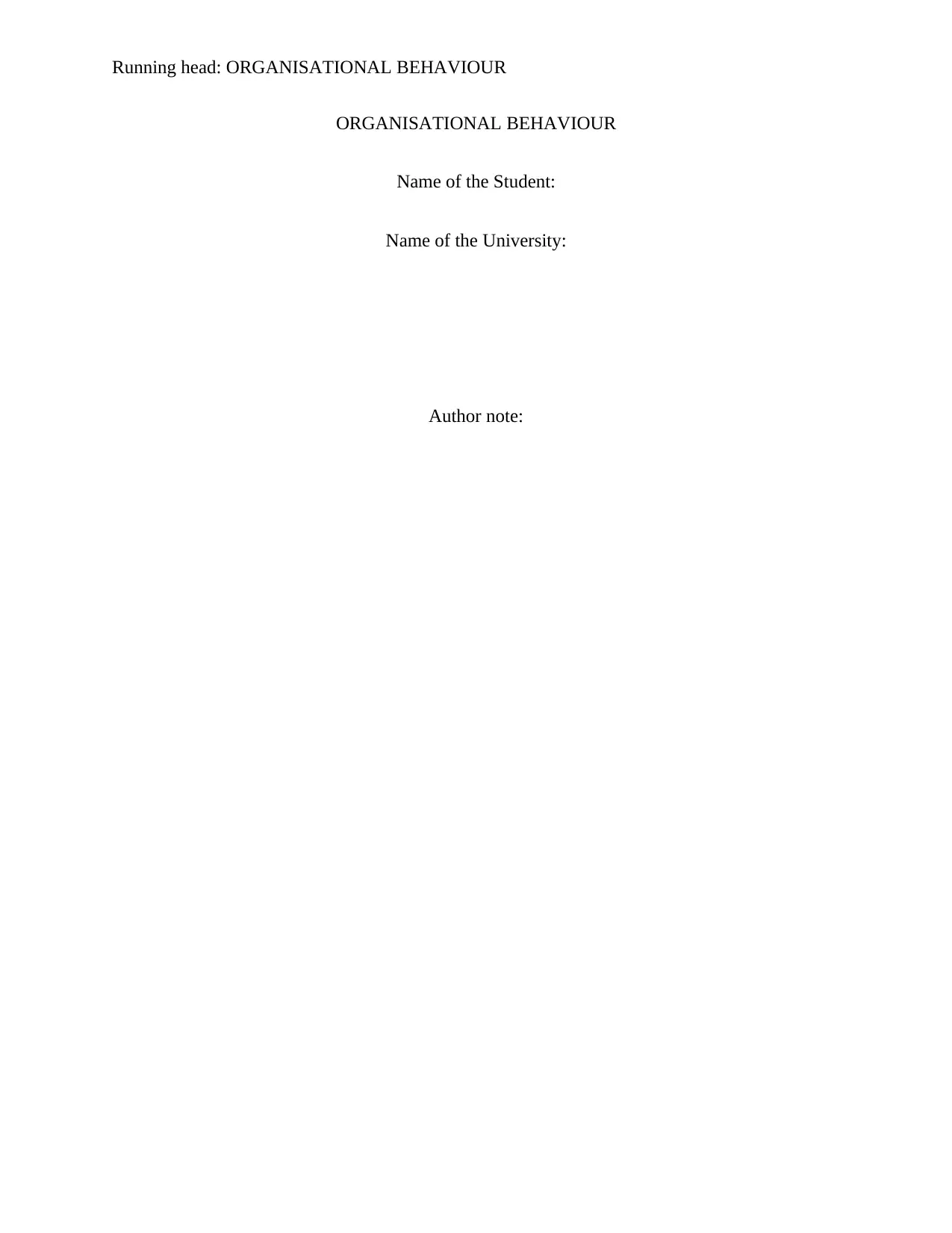
Running head: ORGANISATIONAL BEHAVIOUR
ORGANISATIONAL BEHAVIOUR
Name of the Student:
Name of the University:
Author note:
ORGANISATIONAL BEHAVIOUR
Name of the Student:
Name of the University:
Author note:
Paraphrase This Document
Need a fresh take? Get an instant paraphrase of this document with our AI Paraphraser
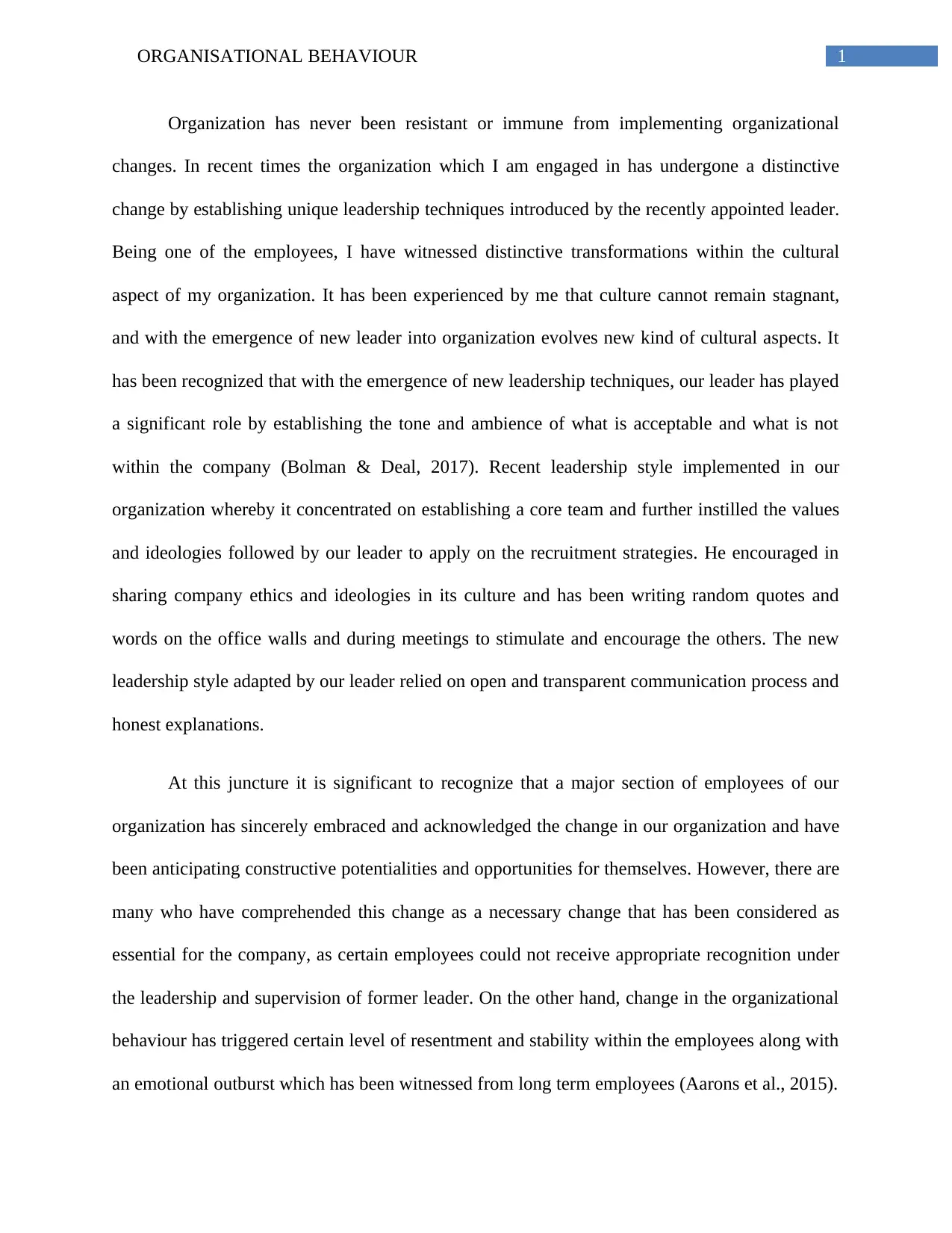
1ORGANISATIONAL BEHAVIOUR
Organization has never been resistant or immune from implementing organizational
changes. In recent times the organization which I am engaged in has undergone a distinctive
change by establishing unique leadership techniques introduced by the recently appointed leader.
Being one of the employees, I have witnessed distinctive transformations within the cultural
aspect of my organization. It has been experienced by me that culture cannot remain stagnant,
and with the emergence of new leader into organization evolves new kind of cultural aspects. It
has been recognized that with the emergence of new leadership techniques, our leader has played
a significant role by establishing the tone and ambience of what is acceptable and what is not
within the company (Bolman & Deal, 2017). Recent leadership style implemented in our
organization whereby it concentrated on establishing a core team and further instilled the values
and ideologies followed by our leader to apply on the recruitment strategies. He encouraged in
sharing company ethics and ideologies in its culture and has been writing random quotes and
words on the office walls and during meetings to stimulate and encourage the others. The new
leadership style adapted by our leader relied on open and transparent communication process and
honest explanations.
At this juncture it is significant to recognize that a major section of employees of our
organization has sincerely embraced and acknowledged the change in our organization and have
been anticipating constructive potentialities and opportunities for themselves. However, there are
many who have comprehended this change as a necessary change that has been considered as
essential for the company, as certain employees could not receive appropriate recognition under
the leadership and supervision of former leader. On the other hand, change in the organizational
behaviour has triggered certain level of resentment and stability within the employees along with
an emotional outburst which has been witnessed from long term employees (Aarons et al., 2015).
Organization has never been resistant or immune from implementing organizational
changes. In recent times the organization which I am engaged in has undergone a distinctive
change by establishing unique leadership techniques introduced by the recently appointed leader.
Being one of the employees, I have witnessed distinctive transformations within the cultural
aspect of my organization. It has been experienced by me that culture cannot remain stagnant,
and with the emergence of new leader into organization evolves new kind of cultural aspects. It
has been recognized that with the emergence of new leadership techniques, our leader has played
a significant role by establishing the tone and ambience of what is acceptable and what is not
within the company (Bolman & Deal, 2017). Recent leadership style implemented in our
organization whereby it concentrated on establishing a core team and further instilled the values
and ideologies followed by our leader to apply on the recruitment strategies. He encouraged in
sharing company ethics and ideologies in its culture and has been writing random quotes and
words on the office walls and during meetings to stimulate and encourage the others. The new
leadership style adapted by our leader relied on open and transparent communication process and
honest explanations.
At this juncture it is significant to recognize that a major section of employees of our
organization has sincerely embraced and acknowledged the change in our organization and have
been anticipating constructive potentialities and opportunities for themselves. However, there are
many who have comprehended this change as a necessary change that has been considered as
essential for the company, as certain employees could not receive appropriate recognition under
the leadership and supervision of former leader. On the other hand, change in the organizational
behaviour has triggered certain level of resentment and stability within the employees along with
an emotional outburst which has been witnessed from long term employees (Aarons et al., 2015).
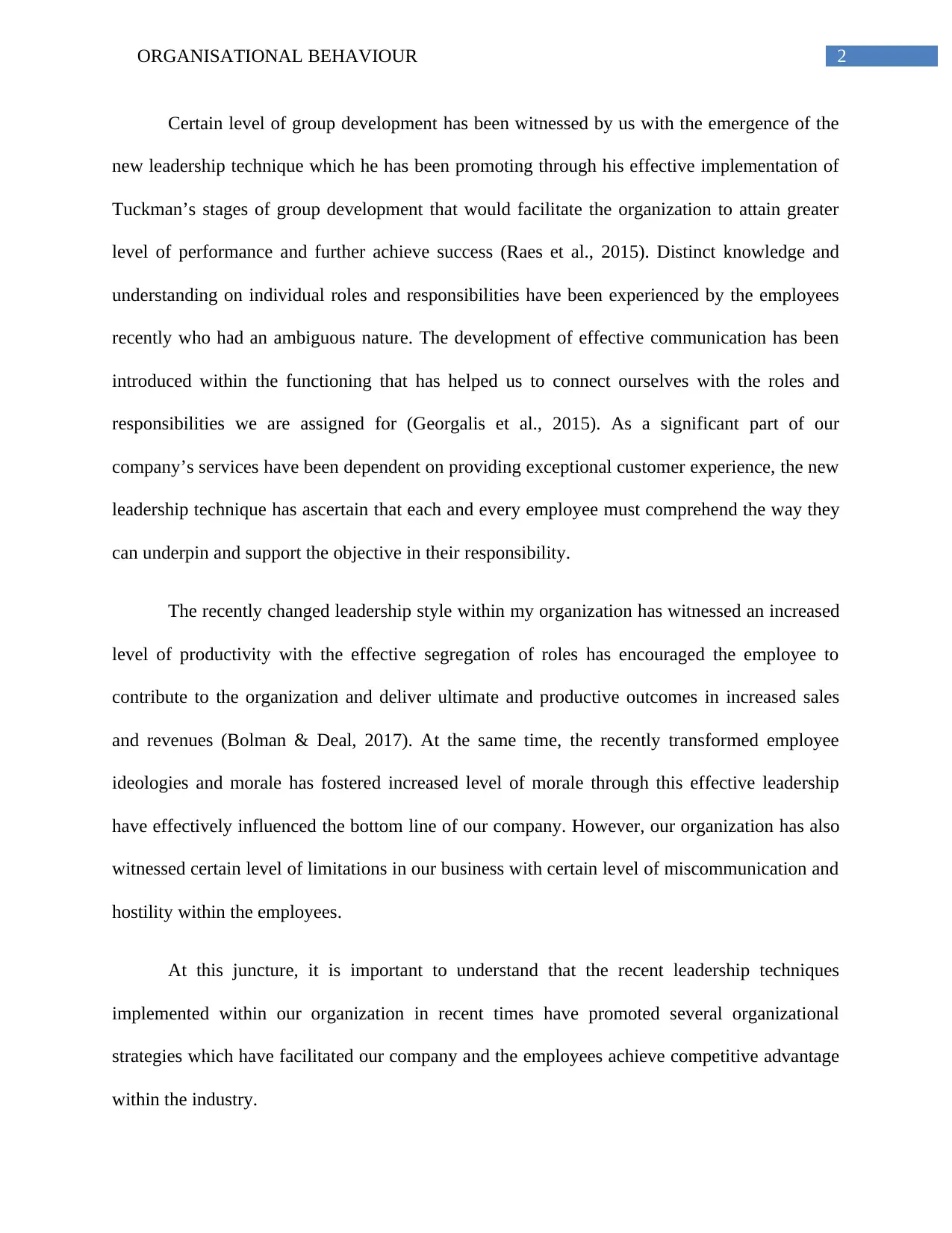
2ORGANISATIONAL BEHAVIOUR
Certain level of group development has been witnessed by us with the emergence of the
new leadership technique which he has been promoting through his effective implementation of
Tuckman’s stages of group development that would facilitate the organization to attain greater
level of performance and further achieve success (Raes et al., 2015). Distinct knowledge and
understanding on individual roles and responsibilities have been experienced by the employees
recently who had an ambiguous nature. The development of effective communication has been
introduced within the functioning that has helped us to connect ourselves with the roles and
responsibilities we are assigned for (Georgalis et al., 2015). As a significant part of our
company’s services have been dependent on providing exceptional customer experience, the new
leadership technique has ascertain that each and every employee must comprehend the way they
can underpin and support the objective in their responsibility.
The recently changed leadership style within my organization has witnessed an increased
level of productivity with the effective segregation of roles has encouraged the employee to
contribute to the organization and deliver ultimate and productive outcomes in increased sales
and revenues (Bolman & Deal, 2017). At the same time, the recently transformed employee
ideologies and morale has fostered increased level of morale through this effective leadership
have effectively influenced the bottom line of our company. However, our organization has also
witnessed certain level of limitations in our business with certain level of miscommunication and
hostility within the employees.
At this juncture, it is important to understand that the recent leadership techniques
implemented within our organization in recent times have promoted several organizational
strategies which have facilitated our company and the employees achieve competitive advantage
within the industry.
Certain level of group development has been witnessed by us with the emergence of the
new leadership technique which he has been promoting through his effective implementation of
Tuckman’s stages of group development that would facilitate the organization to attain greater
level of performance and further achieve success (Raes et al., 2015). Distinct knowledge and
understanding on individual roles and responsibilities have been experienced by the employees
recently who had an ambiguous nature. The development of effective communication has been
introduced within the functioning that has helped us to connect ourselves with the roles and
responsibilities we are assigned for (Georgalis et al., 2015). As a significant part of our
company’s services have been dependent on providing exceptional customer experience, the new
leadership technique has ascertain that each and every employee must comprehend the way they
can underpin and support the objective in their responsibility.
The recently changed leadership style within my organization has witnessed an increased
level of productivity with the effective segregation of roles has encouraged the employee to
contribute to the organization and deliver ultimate and productive outcomes in increased sales
and revenues (Bolman & Deal, 2017). At the same time, the recently transformed employee
ideologies and morale has fostered increased level of morale through this effective leadership
have effectively influenced the bottom line of our company. However, our organization has also
witnessed certain level of limitations in our business with certain level of miscommunication and
hostility within the employees.
At this juncture, it is important to understand that the recent leadership techniques
implemented within our organization in recent times have promoted several organizational
strategies which have facilitated our company and the employees achieve competitive advantage
within the industry.
⊘ This is a preview!⊘
Do you want full access?
Subscribe today to unlock all pages.

Trusted by 1+ million students worldwide
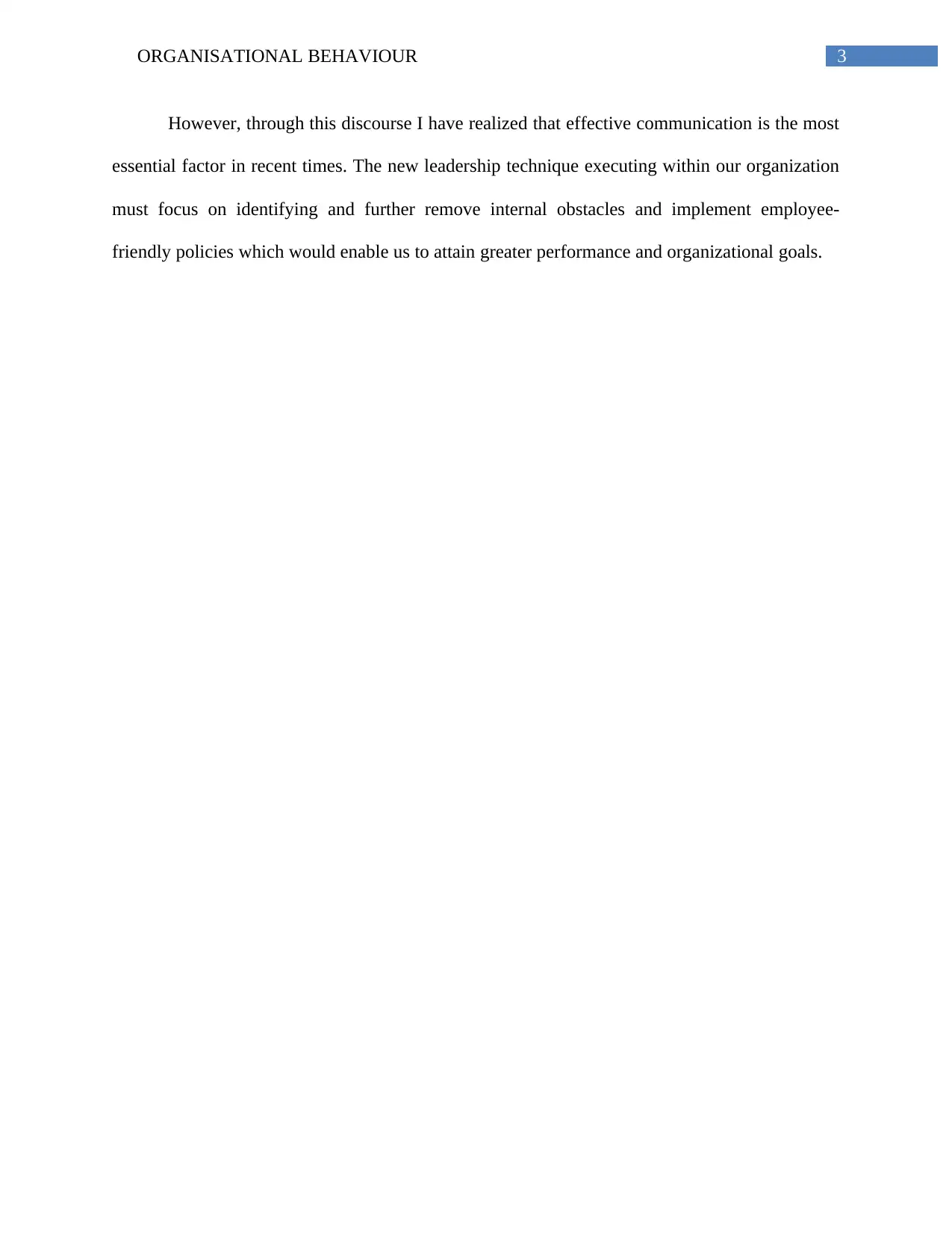
3ORGANISATIONAL BEHAVIOUR
However, through this discourse I have realized that effective communication is the most
essential factor in recent times. The new leadership technique executing within our organization
must focus on identifying and further remove internal obstacles and implement employee-
friendly policies which would enable us to attain greater performance and organizational goals.
However, through this discourse I have realized that effective communication is the most
essential factor in recent times. The new leadership technique executing within our organization
must focus on identifying and further remove internal obstacles and implement employee-
friendly policies which would enable us to attain greater performance and organizational goals.
Paraphrase This Document
Need a fresh take? Get an instant paraphrase of this document with our AI Paraphraser
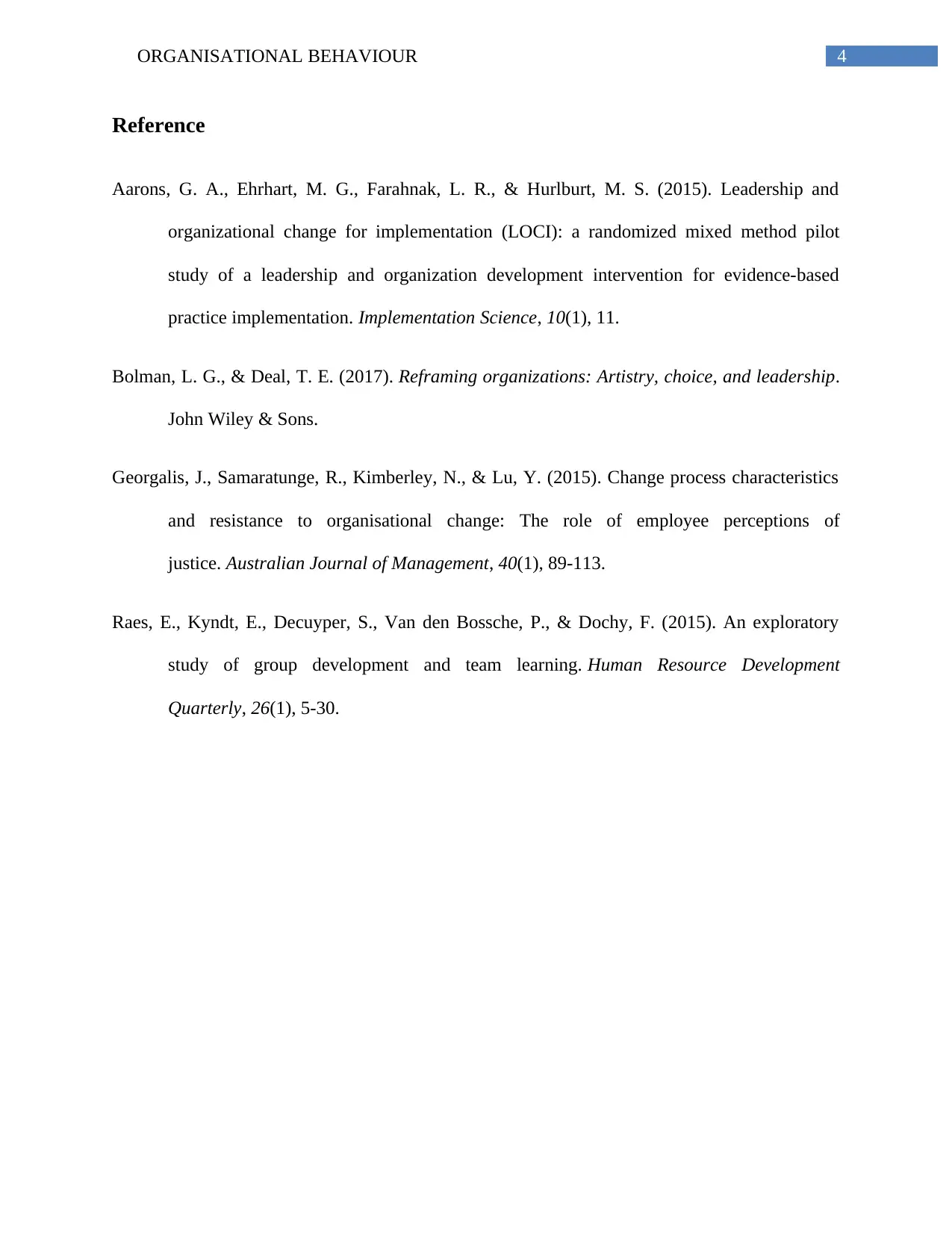
4ORGANISATIONAL BEHAVIOUR
Reference
Aarons, G. A., Ehrhart, M. G., Farahnak, L. R., & Hurlburt, M. S. (2015). Leadership and
organizational change for implementation (LOCI): a randomized mixed method pilot
study of a leadership and organization development intervention for evidence-based
practice implementation. Implementation Science, 10(1), 11.
Bolman, L. G., & Deal, T. E. (2017). Reframing organizations: Artistry, choice, and leadership.
John Wiley & Sons.
Georgalis, J., Samaratunge, R., Kimberley, N., & Lu, Y. (2015). Change process characteristics
and resistance to organisational change: The role of employee perceptions of
justice. Australian Journal of Management, 40(1), 89-113.
Raes, E., Kyndt, E., Decuyper, S., Van den Bossche, P., & Dochy, F. (2015). An exploratory
study of group development and team learning. Human Resource Development
Quarterly, 26(1), 5-30.
Reference
Aarons, G. A., Ehrhart, M. G., Farahnak, L. R., & Hurlburt, M. S. (2015). Leadership and
organizational change for implementation (LOCI): a randomized mixed method pilot
study of a leadership and organization development intervention for evidence-based
practice implementation. Implementation Science, 10(1), 11.
Bolman, L. G., & Deal, T. E. (2017). Reframing organizations: Artistry, choice, and leadership.
John Wiley & Sons.
Georgalis, J., Samaratunge, R., Kimberley, N., & Lu, Y. (2015). Change process characteristics
and resistance to organisational change: The role of employee perceptions of
justice. Australian Journal of Management, 40(1), 89-113.
Raes, E., Kyndt, E., Decuyper, S., Van den Bossche, P., & Dochy, F. (2015). An exploratory
study of group development and team learning. Human Resource Development
Quarterly, 26(1), 5-30.
1 out of 5
Related Documents
Your All-in-One AI-Powered Toolkit for Academic Success.
+13062052269
info@desklib.com
Available 24*7 on WhatsApp / Email
![[object Object]](/_next/static/media/star-bottom.7253800d.svg)
Unlock your academic potential
Copyright © 2020–2025 A2Z Services. All Rights Reserved. Developed and managed by ZUCOL.





